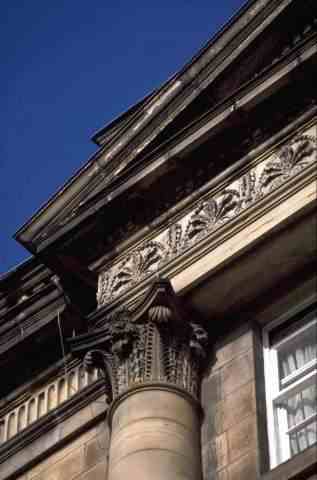|
------------------------------------------------------------- |
||
|
THE CORINTHIAN ORDER |
||
|
Essay by Julian.Small. Photographs by Sandy Kinghorn. |
||
|
|
-------------------------------- |
|
|
|
The Corinthian Order takes its name from the city of Corinth in Greece, but appears to have been developed in Athens during the fifth century BC. The fronds surrounding the capital represent acanthus leaves. The legend surrounding its origins is that a bronze sculptor, visiting the grave of a young girl who had died, noticed a basket containing her toys on top of her grave, covered with a tile to protect the contents. Since the girl's burial, an acanthus plant had grown around and through the basket of toys, curling over at the corners of the tile, thus giving him the idea of a column capital in the shape of a round basket encircled with acanthus leaves. Whatever the truth of this story and the real origins of the Corinthian capital, it is seriously suggested that the earliest examples were made of bronze and only later were examples carved in stone. Initially, it was seen as a decorative variant on the Ionic capital, the other details copying the normal use of the Ionic Order. It is occasionally found in Greek architecture from the fifth century onwards, but its use was greatly developed under the Romans and several variations on the basic type exist. Together with the Doric and Ionic Orders, it is one of the three Classical Orders of Architecture.
The details of the column base, shaft and entablature of the
Corinthian Order are very similar to those of the Ionic Order and,
like the Ionic Order, the entablature incorporates dentils. In
some Roman examples, however, a band of consoles or brackets, not
normally found in the Ionic Order, was added to give extra support to
the projecting cornice. There are several variations on the
design of the capital, and Corinthian capitals employed by Robert
Adam can differ considerably between buildings. The capitals
visible today on the north and south terraces of Charlotte
Square are of a type regularly used by Adam, despite its
construction only after his death, but those used on the facade of Register
House, construction of which was closely supervised by Adam, are
quite different. Adam also, on occasion, might
incorporate details which would not conform to Vitruvius' rules, as
when at Register House he combined the frieze and architrave of the
entablature into a single panel. |
|
|
|
||
|
Adam particularly liked to use the Corinthian Order when he wanted to give the impression of magnificence, as for the west side of the great courtyard of Edinburgh University, intended as a great hall for the University's degree ceremonies and other formal occasions. This is the only part of the University design to use the Corinthian Order. Otherwise, it is probably the order which he most frequently used, preferring it to the Ionic because "all of its sides are regular, and the concavity of its abacus contrasts in a beautiful manner with the convexity of the vase." Register House, the Charlotte Square church, the South Bridge scheme and the terrace of houses designed for Leith Street, of Adam's Edinburgh schemes, all use the Corinthian Order as their principal external decoration. |
||
|
|
|
|
|
Published
by Cadking Design Ltd, Edinburgh, Scotland - Copyright © Cadking
Design 1997-2001
|


